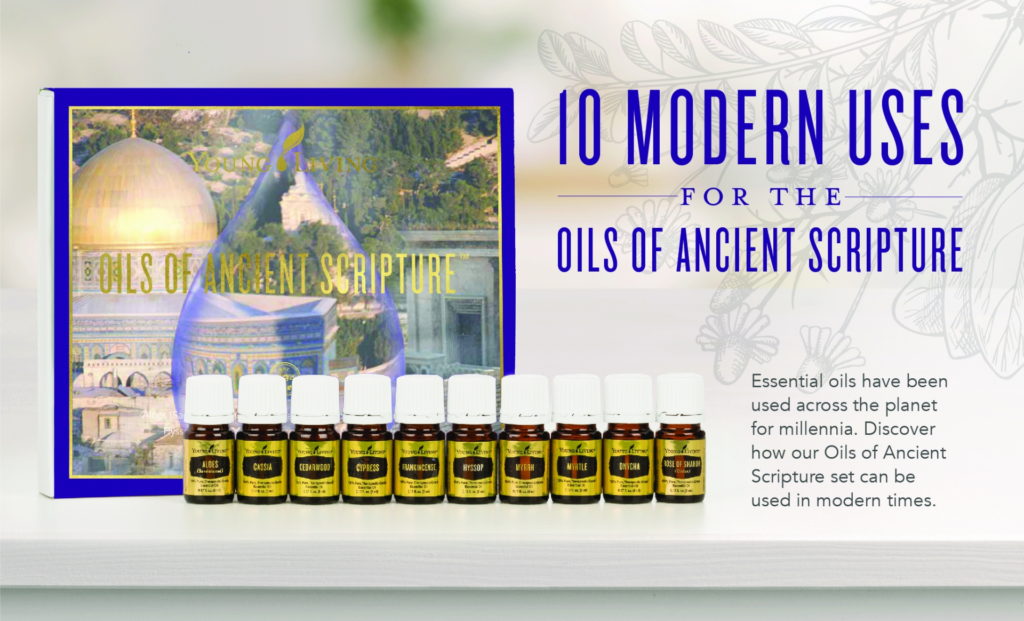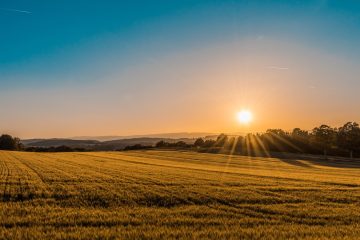Learn how essential oils were used in the Bible and how you can use them today.
Oils were an important part of the lives of people in the Bible.
Olive oil is a liquid fat obtained from olives. It was used daily in the anointing of:
- Jewish kings (1 Kings 1:39)
- Objects (Genesis 28:18)
- Temple (Exodus 30:26)
- Lamps (Leviticus 24:2)
- Offerings in worship to God (Leviticus 2:1)
- Hospitality (Luke 7:36 – 46)
The act of anointing was significant to consecration for holy and sacred use. The practice of anointing with perfumed oil was common. The word anoint has two meanings:
- Anoint – to smear or rub, typically as a part of a religious ceremony
- Anoint – set apart for holy consecration
Essential oils are aromatic, concentrated plant extracts obtained by steam distillation, cold pressing, or resin tapping from shrubs, plants, resins, trees, flowers, fruit, and herbs.
History
There are at least 33 species of aromatic plants mentioned in the Bible and as many as 1,031 references to essential oils and the plants that produce them (ointments, perfumes, spices).
The Bible was written by 40 men, inspired by God (2 Timothy 3:16 – 17) over a span of 1500 years. Most of these men were not alive at the same time yet they proclaim the same message throughout the entire Bible – God loves you.
The Bible covers 3 continents – Asia, Africa, and Europe.
The Bible covers 3 periods of time/ages.
| Age | Years Lasted | How God Dealt with Mankind | Began – End |
| Patriarchal | 2500 | Fathers – head of families | Adam – giving of law through Moses |
| Mosiac | 1500 | As a nation through the law of Moses | Moses giving law – Christ on the cross |
| Christian | 2000+ | Through Jesus and the Bible | 1st Pentecost after Christ resurrection – Christ return |
In Genesis chapters 1 and 2 we see the creation of man and everything man needs to sustain his life on earth, that includes plants. Essential oils come from plants. Plants have been a part of our lives since the beginning of time.
Essential Oils are First Mentioned in the Bible in Genesis Chapter 37
Joseph was sold to Midian traders who carried spices, balm, and myrrh (Genesis 37: – 23 -28).

There is Nothing Spiritual About Essential Oils. God is Spirit (John 4:24). Essential oils come from plants and are physical. They support the systems of the human physical body (circulatory, immune, muscular, nervous, skeletal, endocrine, exocrine, reproductive, and renal).
Essential oils can support the nervous system – the body relaxes which makes it easier to concentrate on activities that require focus such as reading Scripture, praying, or working.
I am not a medical professional. I am sharing what I have learned from my research and daily use of essential oils. The information and products I am sharing are not intended to treat, diagnose, prevent, or cure any disease or illness. Consult a medical professional before acting on any information presented here.
10 Oils of Ancient Scripture
Frankincense (Boswellia)
How Harvested: Steam distillation from resin
Where in the world? Somalia, Africa
Fun Fact: The Hebrew word for frankincense, lenovah (sometimes translated as “incense”), appears in the Bible 22 times.
Biblical Uses: Religious ceremonies, burial preparations, was as valuable as gold in Biblical days, Jesus received frankincense at His birth
Scripture: Matthew 2:11
And when they were come into the house, they saw the young Child with Mary, His mother, and fell down, and worshipped Him: and when they had opened their treasures, they presented unto Him gifts; gold, and frankincense, and myrrh.
Modern Use: Diffuse for relaxation, rub 1 – 2 drops on temples or wrists before praying or reading Scripture, add to facial routine for even skin tone, rub 1 – 2 drops in hand, cup hand over nose, and inhale deeply
Myrrh (Commiphora myrrha)
How Harvested: Steam distillation from resin
Where in the world? Somalia, Africa
Fun Fact: It is mentioned in one of the oldest known medical records, the Ebers Papyrus (dating from 16th century BC), an ancient Egyptian list of 877 prescriptions and recipes.
Biblical Uses: Childbirth – used on umbilical cords of newborns to protect navel infection, used as beauty treatments
Scripture: Esther 2:12
Each young woman’s turn came to go in to King Ahasuerus after she had completed twelve months’ preparation, according to the regulations for the women, for thus were the days of their preparation apportioned: six months with oil of myrrh, and six months with perfumes and preparations for beautifying women.
Modern Use: Skin support, add to facial routine, today many oral hygiene products use myrrh
Cypress (Cupressus sempervirens)
How Harvested: Steam distillation from branches
Where in the world? France; Spain, Europe
Fun Fact: The tree shares its name with the Island of Cypress. Cypress wood is noted for its durability.
Biblical Uses: Used to reduce scar tissue, Phoenicians and Cretans used to build ships and bows
Scripture: Isaiah 44:14
He cuts down cedars for himself, and takes the cypress and the oak; he secures it for himself among the trees of the forest. He plants a pine, and the rain nourishes it.
Modern Use: DIY muscle cream – dilute with a carrier oil (olive, coconut, almond, etc.) and rub on your muscles
Cedarwood (Cedrus Atlantica)
How Harvested: Steam distillation from bark
Where in the world? Morocco, Africa; USA
Biblical Uses: Cleansing of lepers; embalming
Fun Fact: Cedar trees can live up to 300 years and grow 120 feet tall
Scripture: Leviticus 14:1 – 4
Then the Lord spoke to Moses, saying, “This shall be the law of the leper for the day of his cleansing: He shall be brought to the priest. And the priest shall go out of the camp, and the priest shall examine him; and indeed, if the leprosy is healed in the leper, then shall the priest command to take for him that is to be cleansed two birds alive and clean, and cedarwood, and scarlet, and hyssop:
Modern Use: Diffuse for relaxation, moisturize hair (mixwith acarrier oil – olive, coconut, almond, etc.) and massage scalp, add to facial routine
Hyssop officinalis
How Harvested: Steam distillation from stems and leaves
Where in the world? France; Hungary, Europe; Utah, USA
Fun Fact: In 1745 one writer suggested 18 different plants for the Biblical hyssop. While the exact variety may not be known, a cleansing property is suggested because it was employed in many purification rites.
Biblical Uses: Passover, Israelites dipped a hyssop branch in lamb’s blood to put on doorways as protection from the death angel, used to cleanse and purify
Scripture: Exodus 12:21 – 22
Then Moses called for all the elders of Israel and said to them, “Pick out and take lambs for yourselves according to your families and kill the Passover lamb. And you shall take a bunch of hyssop, dip it in the blood that is in the basin, and strike the lintel and the two doorposts with the blood that is in the basin. And none of you shall go out of the door of his house until morning.
Psalm 51:7 NASB Purify me with hyssop, and I will be clean; cleanse me, and I will be whiter than snow.
Modern Use: Skin support(mix with acarrier oil – olive, coconut, almond, etc.) and apply to minor cuts, burns, and scrapes
Onycha
How Harvested: Resin
Where in the world? Not determined
Fun Fact: Dissolved in ethyl alcohol, it has been used for more than 200 years as “Tincture of Benzoin” as an effective hospital antiseptic.
Biblical Uses: Blended in the holy anointing oil
Scripture: Exodus 30:34 – 36
And the Lord said to Moses: “Take sweet spices, stacte and onycha and galbanum, and pure frankincense with these sweet spices; there shall be equal amounts of each. You shall make of these an incense, a compound according to the art of the perfumer, salted, pure, and holy. And you shall beat some of it very fine, and put some of it before the Testimony in the tabernacle of meeting where I will meet with you. It shall be most holy to you.
Modern Use: Diffuse, skin support – mixwith acarrier oil (olive, coconut, almond, etc.) and massage on dry, cracked skin
Aloes/Sandalwood (Santalum album)
How Harvested: Steam distillation from wood of tree
Where in the world? Australia
Fun Fact: Sandalwood is one of the most expensive trees in the world. Items made from sandalwood are very expensive.
Biblical Uses: Embalming
Scripture: John 19:38 – 42
After this, Joseph of Arimathea, being a disciple of Jesus, but secretly, for fear of the Jews, asked Pilate that he might take away the body of Jesus; and Pilate gave him permission. So he came and took the body of Jesus. And Nicodemus, who at first came to Jesus by night, also came, bringing a mixture of myrrh and aloes, about a hundred pounds. Then they took the body of Jesus, and bound it in strips of linen with the spices, as the custom of the Jews is to bury. Now in the place where He was crucified, there was a garden, and in the garden a new tomb in which no one had yet been laid. So there they laid Jesus, because of the Jews’ Preparation Day, for the tomb was nearby.
Modern Use: Skin support – add a few drops to your facial moisturizer or mix with a carrier oil (olive, coconut, almond, etc.) and moisturize your body
Myrtle (Myrtus communis)
How Harvested: Steam distillation from leaves
Where in the world? Tunisia, Morocco, Africa
Fun Fact: Myrtle is a girl’s name derived from the plant Myrtus. It was popular during the Victorian age, along with other plant and flower names.
Biblical Uses: Purification, religious ceremonies
Scripture: Nehemiah 8:15
and that they should announce and proclaim in all their cities and in Jerusalem, saying, “Go out to the mountain, and bring olive branches, branches of oil trees, myrtle branches, palm branches, and branches of leafy trees, to make booths, as it is written.”
Modern Use: Diffuse, skin conditions, chest rub – mix with a carrier oil (olive, coconut, almond, etc.) and rub on chest
Rose of Sharon/Rock Rose/Cistus (Cistus ladaniferus)
How Harvested: Steam distillation from branches
Where in the world? Spain, France
Fun Fact: In ancient times cistus was collected by combing the beards and thighs of goats and sheep that had grazed on the cistus shrubs.
Biblical Uses: Perfume
Scripture: Song of Solomon 2:1
I am the rose of Sharon and the lily of the valleys.
Modern Use: Diffuse for relaxation, add a few drops to 1 – 2 cups of Epsom salt for a relaxing bath
Cassia (Cinnamomum cassia)
How Harvested: Steam distillation from tree bark
Where in the world? China
Fun Fact: It is mentioned in one of the oldest known medical records, the Ebers Papyrus (dating from 16th century BC), an ancient Egyptian list of 877 prescriptions and recipes.
Biblical Uses: Holy anointing oil
Scripture: Psalm 45:8
All Your garments are scented with myrrh and aloes and cassia, out of the ivory palaces, by which they have made you glad.
Modern Use: Diffuse, some like to wear on pulse points (behind ear, inside of elbow, behind knee, or bottom of throat) as perfume
I hope you are as amazed as I am in learning about oils in ancient Scripture.
I was most amazed at the invigorating aromas that filled the room as I opened each bottle when writing this blog. I can only imagine the aroma as worshippers of God were anointed or offered aromatic oils to God in Biblical times.
Each of these 10 Oils of Ancient Scripture comes in a special bundle from Young Living Essential Oils.
Where you purchase your essential oils is important SeedtoSeal.com
- Check out my FREE email course “Essential Oils 101 for Women in Ministry” to learn more about essential oils, 5 ways to use essential oils in ministry for yourself and others, the importance of the QUALITY of essential oils, and the importance of WHERE you purchase them
God bless you
Channetta Williams Young Living Essential Oils Brand Partner # 12587583



0 Comments